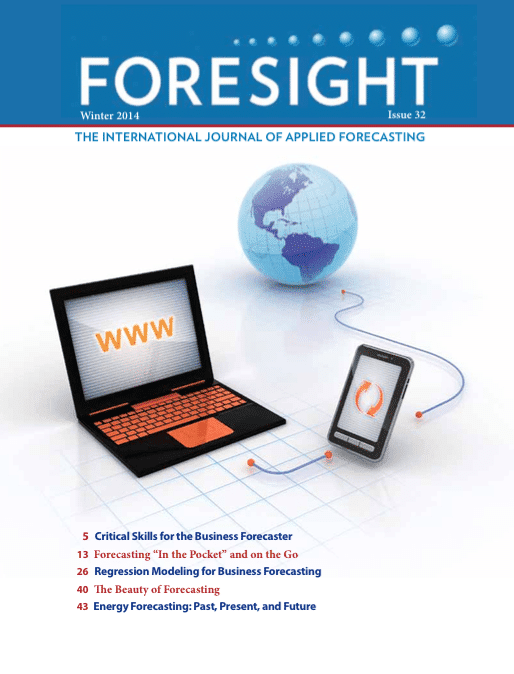FORESIGHT, Issue 32
$45.00
Description
Winter 2014
Special Feature: Critical Skills for the Business Forecaster
- Critical Skills for the Business Forecaster Sujit Singh
Sujit Singh details the knowledge and proficiencies essential for today’s business forecasters and planners. His list is long – perhaps even a bit intimidating – and serves as a virtual job description for organizational candidates. If you’ve earned the title of “successful forecaster,” take gratification in the skills you’ve learned and brought to the job.
- Forecaster in the Field: an interview with Sujit Singh
Articles
- Forecasting “In The Pocket”: Mobile Devices Can Improve Collaboration by Stavros Asimakopoulos, George Boretos, Constantinos Mourlas
The increasing popularity of PDAs, smartphones, tablet computers, and other mobile devices opens up new opportunities for communication and collaboration on business forecasts. As the authors tell us, mobile forecasting (m-forecasting) applications may streamline approaches to collaboration between retailers and suppliers, thus contributing to the provision and exchange of product information, especially since forecasts are strongly tied to local context knowledge. In this article, we present specific approaches for the future of m-forecasting applications. - Regression Modeling for Business Forecasting by Geoff Allen
Foresight tutorials are designed to be nontechnical overviews of important methodologies, enabling business forecasters to make more informed use of their forecasting software. In this tutorial on regression modeling, Geoff Allen takes us through the origin and structure of a regression model, lays out the key conditions for obtaining reliable regression forecasts, and illustrates the diagnostic tests that help improve model specification. - Do Forecasting Methods Reduce Avoidable Error? Evidence from Forecasting Competitions by Steve Morlidge
The set of M-competitions – comparing the forecasting accuracy of two dozen common time series methods – is a landmark in our understanding of how different methods fare on a variety of data types. For example, one common procedure, the trend line extrapolation available in Excel, emerged as the least accurate of all, and probably should be considered a must to avoid. Yet, as Steve Morlidge tells us here, the implications for practitioners, especially demand forecasters, are not widely understood and quite possibly overlooked by most. Steve not only summarizes the key implications, he also uses a selection of data from the M3-Competition – the most recent (year 2000) and most comprehensive – to shed additional light on the bounds of forecastability: the best (and worst)forecast accuracy we can expect to achieve. - The Beauty of Forecasting by David Orrell
In a 2009 news article entitled “How Did Economists Get It So Wrong?,” Paul Krugman wrote, “The economics profession went astray because economists, as a group, mistook beauty, clad in impressive looking mathematics, for truth.” In this article, David Orrell asks if the same could be said of forecasters. - Energy Forecasting: Past, Present, and Future by Tao Hong
When you flick that switch, you expect the lights to go on – but the business of keeping them on is not nearly as straightforward. Dr. Tao Hong offers a practical overview of energy forecasting; it’s an important task, one that electric utilities have been doing daily for over a century, but now with new challenges.







